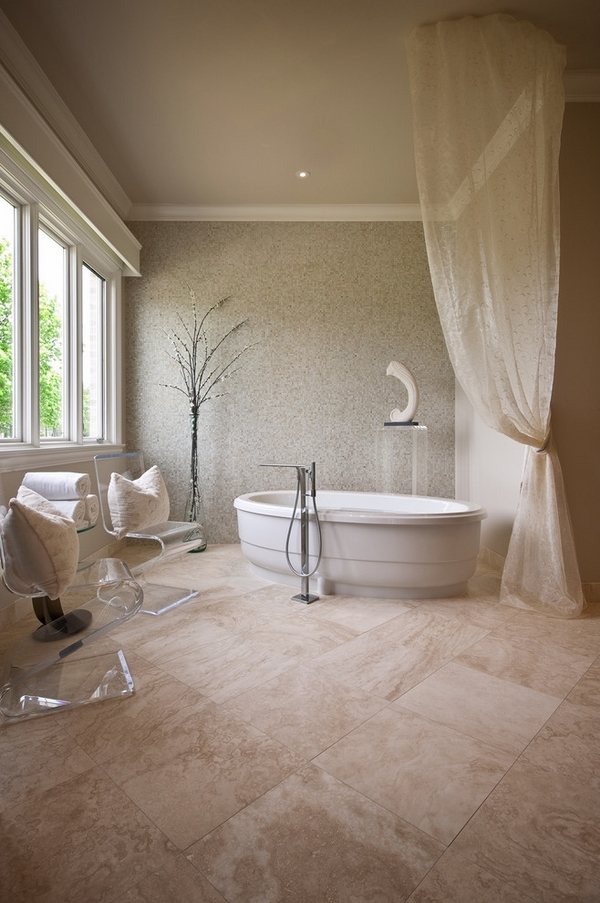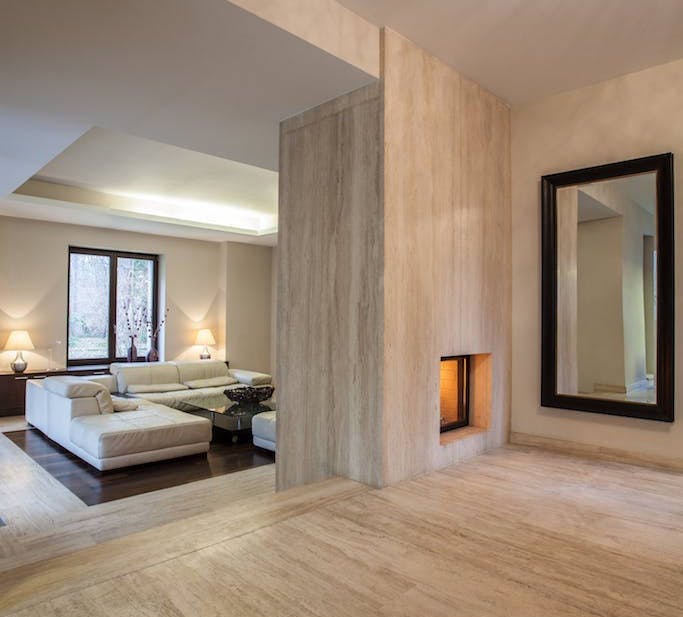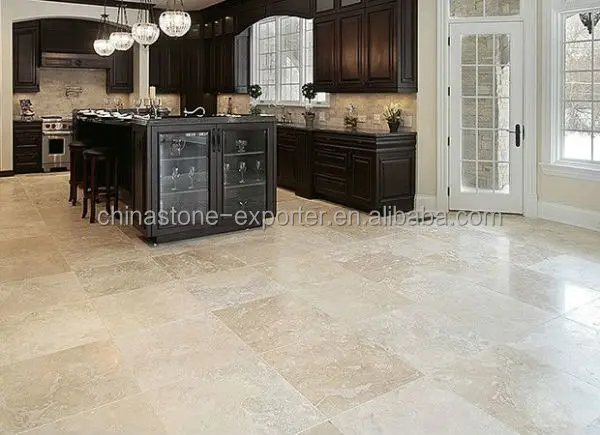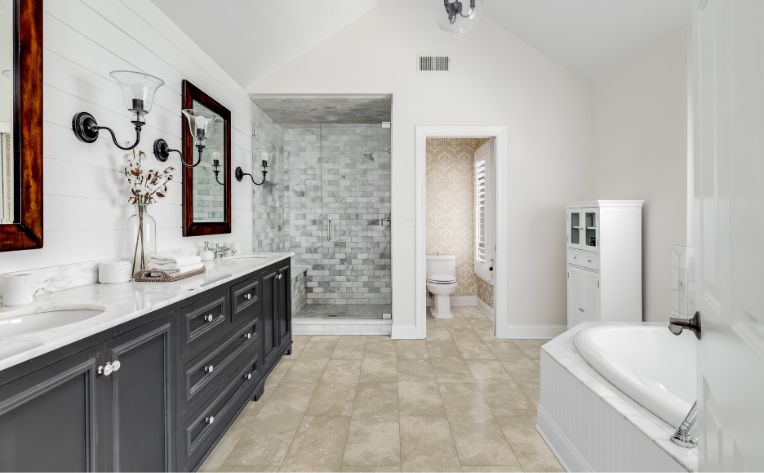What is Travertine Marble Flooring?
If you’re exploring options for elegant and durable flooring, you’ve probably encountered the term travertine marble flooring. But what exactly is it, and what makes it so special? Travertine is a natural stone that has been used in construction for thousands of years. Found in hot springs or limestone caves, it’s formed by the precipitation of calcium carbonate, which gives it its distinct porous structure. This material has a marble-like appearance but is technically a type of limestone.
- A Look Into Its History: Travertine dates back to ancient civilizations, with iconic structures like the Roman Colosseum showcasing its strength and timeless beauty. Today, it remains a popular choice for both traditional and contemporary designs, proving that some materials truly stand the test of time.
- How It Differs from Other Stones: Unlike granite or pure marble, travertine has a softer, more textured surface due to its natural voids and pits. These features can be left untouched for a rustic look or filled for a smoother, more polished finish. This versatility makes it a favorite among designers and homeowners alike.
- The Unique Characteristics of Travertine: Travertine comes in earthy tones ranging from creamy whites to deep rusts, which lend a natural and organic feel to any space. Its neutral palette complements various design aesthetics, from minimalist to luxurious. The stone’s layered appearance often features subtle variations in color and pattern, adding depth to flooring.
- Common Applications Beyond Flooring: Although we’re focusing on flooring, it’s worth mentioning that travertine is also widely used for walls, countertops, and outdoor patios. Its adaptability and durability make it a go-to choice for both indoor and outdoor projects.
- Why It’s Worth Considering: Travertine flooring brings the beauty of nature indoors while offering a durable surface that can withstand heavy foot traffic. Its rich history, unique texture, and timeless appeal make it more than just a functional choice—it’s a statement piece for your home.

The Natural Beauty of Travertine Marble
One of the first things that draws people to travertine marble flooring is its natural beauty. If you’ve ever walked into a room with travertine floors, you know the feeling—luxury paired with a grounded, earthy charm.
The Color Palette: Subtle and Sophisticated
Travertine comes in a range of hues that evoke the warmth of nature. From soft ivories and beiges to golden hues and rich browns, there’s a shade for every design preference. Some stones even feature hints of silver or red, adding complexity and vibrancy.
The Textural Appeal
One of the most remarkable aspects of travertine is its texture. The stone’s porous nature gives it a unique surface that can be left rough for a rustic feel or smoothed for a sleek, polished look. The tactile quality of travertine adds depth and character to any room.
The Unique Veining and Patterns
Each piece of travertine is like a work of art. The natural veining and patterns vary from tile to tile, ensuring that your floor is one of a kind. These variations create visual interest and give the flooring a dynamic, organic quality.
How It Elevates Interior Design
Travertine’s understated elegance can elevate any space. Whether you’re designing a spa-like bathroom, a Mediterranean-style kitchen, or a grand entryway, this stone adds an air of sophistication that’s hard to match.
The Timeless Appeal
Unlike trendy materials that may fall out of fashion, travertine’s classic look ensures it will remain stylish for decades. It’s a safe yet stunning choice for those looking to invest in long-lasting beauty.
Outdoor Applications That Shine
The natural beauty of travertine isn’t confined to indoor spaces. Its earthy tones and weather-resistant qualities make it a favorite for outdoor patios, pool decks, and garden paths. It’s as much a part of nature as the landscapes it complements.
Advantages of Travertine Marble Flooring
Choosing travertine marble flooring comes with numerous benefits. Let’s dive into the advantages that make it a worthwhile investment for homeowners.
Timeless Aesthetic Appeal
Travertine marble flooring boasts a natural beauty that transcends trends. Its earthy tones and classic look fit seamlessly into virtually any design style, from rustic to modern.
Exceptional Durability
Travertine is tough enough to withstand the wear and tear of daily life. Its resilience makes it a smart choice for high-traffic areas like kitchens, hallways, and living rooms.
Versatility Across Spaces
One of travertine’s biggest advantages is its versatility. Whether you’re renovating a bathroom, installing flooring in a foyer, or designing an outdoor patio, this material adapts beautifully to various environments.
Eco-Friendly Material
Travertine is a natural, recyclable material, making it an environmentally conscious choice. Its production process has a lower carbon footprint compared to synthetic alternatives, which is a bonus for eco-conscious homeowners.
Adds Property Value
Investing in travertine flooring can significantly enhance the value of your home. Potential buyers are often drawn to its luxurious appearance and durability, making it a selling point for your property.
Temperature Regulation
Travertine’s natural properties help regulate temperature. It stays cool in the summer and retains warmth in the winter, making it a practical choice for all seasons.
Potential Drawbacks to Consider
While travertine marble flooring has many advantages, it’s important to weigh the potential drawbacks before making a final decision. Being aware of its limitations can help you decide if it’s the right choice for your home.
Porosity and Staining Concerns
One of the biggest challenges with travertine is its porosity. The stone’s natural voids make it susceptible to staining if liquids like wine, coffee, or oil are spilled and not cleaned immediately. Sealing the surface can mitigate this issue, but it requires regular maintenance.
Susceptibility to Scratches and Chips
Although durable, travertine is softer than granite or porcelain tiles. Heavy furniture or dropped objects can cause chips, cracks, or scratches. It’s essential to handle the material with care, especially during installation.
Maintenance Requirements
Travertine flooring demands a bit more attention than other flooring options. Regular sealing is necessary to protect against stains and moisture damage. Routine cleaning with gentle, pH-neutral cleaners is also crucial to prevent the surface from losing its luster.
Cost Considerations
Travertine is not the most budget-friendly flooring option. While it’s often less expensive than high-end marble, the cost of the material, installation, and upkeep can add up. It’s important to factor these expenses into your budget.
Cold and Hard Underfoot
Like most stone flooring, travertine can feel cold and hard underfoot, especially in colder climates. Area rugs or underfloor heating systems can help alleviate this discomfort.
Vulnerability to Acidic Substances
Travertine reacts negatively to acidic substances like vinegar or citrus juice. These can cause etching, leaving dull spots on the surface. Care must be taken to avoid using harsh cleaners or allowing acidic spills to linger.
Travertine vs. Other Flooring Materials
When choosing flooring, comparing travertine with other materials helps clarify its unique value. Let’s examine how it stacks up against popular alternatives.
Travertine vs. Ceramic Tile
Ceramic tiles are budget-friendly and come in endless designs, but they lack the natural elegance and timeless charm of travertine. While ceramic tiles are easier to maintain, they can’t replicate the organic textures and patterns that make travertine stand out.
Travertine vs. Marble
Both travertine and marble exude luxury, but marble has a more polished and formal appearance. Travertine, by contrast, offers a more rustic, earthy aesthetic. Travertine is generally more affordable than marble but requires more maintenance.
Travertine vs. Granite
Granite is harder and more resistant to scratches than travertine, making it a better choice for areas prone to heavy wear. However, granite lacks the soft, warm tones of travertine, which makes travertine preferable for creating a cozy ambiance.
Travertine vs. Hardwood
Hardwood floors bring warmth and classic beauty but are prone to scratches and water damage. Travertine offers superior durability in moisture-prone areas like bathrooms and kitchens, where hardwood might struggle.
Travertine vs. Vinyl or Laminate
Vinyl and laminate flooring are cost-effective and easy to install, but they lack the authenticity of natural stone. While these options can mimic the look of travertine, they can’t match its texture or long-lasting appeal.
Travertine vs. Concrete
Concrete flooring shares the travertine’s industrial edge and durability. However, it lacks the variety of colors and patterns found in travertine, making it less versatile for certain design styles.
Installation Process for Travertine Marble Flooring
Installing travertine marble flooring is a meticulous process that requires attention to detail. Here’s what you need to know about the steps involved.
Preparing the Subfloor
The first step is preparing the subfloor, which must be clean, dry, and level. Any imperfections in the subfloor can affect the final look of the tiles. A cement backer board is often installed to provide a stable base.
Planning the Layout
Before laying the tiles, it’s important to plan the layout. This involves dry-fitting the tiles to determine their arrangement, ensuring consistent spacing, and making necessary adjustments for visual balance.
Cutting the Tiles
Travertine tiles may need to be cut to fit corners, edges, or other irregular spaces. This requires a wet saw with a diamond blade to ensure clean, precise cuts without cracking the stone.
Applying the Adhesive
A high-quality thin-set adhesive is applied to the subfloor using a notched trowel. The adhesive should be spread evenly to ensure a strong bond between the tiles and the subfloor.
Laying the Tiles
The tiles are laid carefully, starting from the center of the room and working outward. Spacers are used to maintain uniform grout lines. Attention to detail is crucial to prevent uneven edges.
Grouting and Sealing
Once the adhesive has cured, grout is applied to fill the gaps between the tiles. The final step is sealing the travertine to protect it from stains and moisture. A high-quality sealant is essential for preserving the stone’s beauty.
Caring for and Maintaining Travertine Floors
Travertine floors require regular care to keep them looking their best. Here’s a comprehensive guide to maintaining this stunning material.
Cleaning Tips
Sweep or vacuum regularly to remove dirt and debris that could scratch the surface. Use a damp mop with a pH-neutral cleaner designed for natural stone to clean the tiles without damaging the sealant.
Sealing the Surface
Travertine’s porous nature makes sealing essential. A high-quality stone sealant should be applied during installation and reapplied periodically, typically every 1-2 years, depending on usage.
Addressing Stains
If spills occur, clean them immediately to prevent staining. For tougher stains, use a poultice specifically designed for natural stone to lift the stain without damaging the surface.
Preventing Scratches
Place felt pads under furniture legs to prevent scratches. Use rugs or mats in high-traffic areas to reduce wear and tear.
Avoiding Harsh Cleaners
Avoid acidic or abrasive cleaners, as they can etch or dull the surface. Stick to mild, stone-safe products to preserve the flooring’s finish.
Routine Inspections
Periodically inspect your travertine flooring for chips, cracks, or other damage. Addressing minor issues promptly can prevent larger problems down the line.
Is Travertine Marble Flooring Right for You?
Choosing the right flooring is a personal decision that depends on several factors. Let’s explore whether travertine marble flooring aligns with your needs and lifestyle.
Aesthetic Preferences
If you value natural beauty, warm tones, and unique textures, travertine is an excellent choice. Its timeless appeal complements a wide range of design styles, making it a versatile option.
Budget Considerations
Travertine is an investment, so it’s important to weigh its cost against your budget. While it may be more expensive upfront, its durability and elegance can add long-term value to your home.
Maintenance Commitment
Travertine requires regular maintenance, including sealing and gentle cleaning. If you’re willing to invest time and effort into upkeep, this flooring can reward you with lasting beauty.
Room Usage
Consider the function of the space where you’re installing travertine. It’s ideal for areas where durability and aesthetics are priorities but may not be the best choice for spaces exposed to heavy moisture without proper sealing.
Climate and Comfort
If you live in a warm climate, travertine’s cool surface can be a welcome feature. In colder regions, pairing it with underfloor heating can enhance comfort.
Longevity and Style
Travertine is a long-term choice. Its timeless appeal ensures that it won’t go out of style, making it a sound investment for those seeking lasting elegance.
What Is Travertine Tile? Flooring America
Related Posts:







